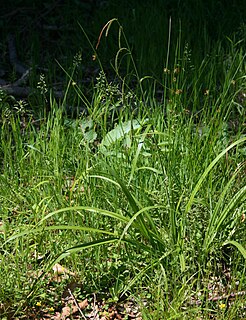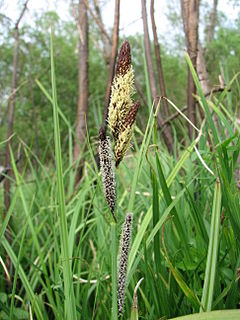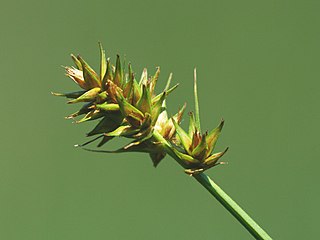
Rhynchospora colorata, also known as starrush whitetop, white star sedge and white-topped sedge, is a perennial sedge with white bracts, giving it the appearance of white petals with long, green points. It is native to southeastern North America, from Virginia west to New Mexico in the United States, and south into the Caribbean islands.

In botany, a glume is a bract below a spikelet in the inflorescence of grasses (Poaceae) or the flowers of sedges (Cyperaceae). There are two other types of bracts in the spikelets of grasses: the lemma and palea.

A spikelet, in botany, describes the typical arrangement of the flowers of grasses, sedges and some other Monocots.

Carex limosa is a species of sedge known as bog-sedge, mud sedge, and shore sedge.

Cyperus fuscus is a species of sedge known by the common name brown galingale, or brown flatsedge. This plant is native to much of Europe, Asia and North Africa from England, Portugal and Morocco east to China and Thailand. It is an introduced species in North America, where it is naturalized in widely scattered locations in the United States and Canada.

Eleocharis quinqueflora is a species of spikesedge known by the common names fewflower spikerush and few-flowered spike-rush. It is widespread across Europe, North Africa, northern Asia, and North America. There are also isolated populations in Argentina and Chile.

Carex pendula is a large sedge of the genus Carex. It occurs in woodland, scrubland, hedges and beside streams, preferring damp, heavy clay soils. It is sometimes grown as a garden plant because of its distinctive appearance.

Carex buxbaumii is a species of sedge known as Buxbaum's sedge or club sedge. It is native to much of the northern Northern Hemisphere, from Alaska to Greenland to Eurasia, and including most of Canada and the United States. It grows in wet habitat, such as marshes and fens. This sedge grows in clumps from long rhizomes. The stems are 75–100 cm (30–39 in) in maximum height. The leaves are narrow and small. The inflorescence has a bract which is sometimes longer than the spikes. The fruits have dark-colored bracts and a sac called a perigynium or utricle which is gray-green and rough in texture.

Carex diandra is a species of sedge known by the common names lesser tussock-sedge and lesser panicled sedge.

Carex hassei is a species of sedge known by the common name salt sedge. It is native to western North America from British Columbia to Baja California to New Mexico, where it grows in moist places, such as meadows.

Carex leporina is a species of sedge known in the British Isles as oval sedge and in North America as eggbract sedge. It is native to Eurasia and eastern and western North America, where it grows in seasonally wet habitat, such as meadows and fields. This sedge produces many thin stems and narrow leaves. The inflorescence is an open cluster of several flower spikes. The pistillate flower has a reddish or brownish bract with a gold center and white tip.

Carex vulpinoidea is a species of sedge known as fox sedge and American fox-sedge. It is native to North America, including most of Canada, the Dominican Republic, the United States and parts of Mexico. It is known in Europe and New Zealand as an introduced species. The sedge lives in wet and seasonally wet habitat, and grows easily as a roadside weed. It produces clumps of stems up to a meter tall. The inflorescence is a dense, tangled cluster of many flower spikes up to about 10 cm (3.9 in) long. Tolerates fluctuating water levels and periods of drying.

Carex acutiformis, the lesser pond-sedge, is a species of sedge.

Isolepis setacea is a species of flowering plant in the sedge family known by the common names bristle club-rush and bristleleaf bulrush. It is native to Eurasia and Africa, and possibly Australasia. It can be found in other places, including some areas in North America, where it is an introduced species. It grows in many types of moist and wet habitat, often in coastal regions, and sometimes inland. It is a perennial herb which forms mats of very thin, grooved, erect or arching stems up to about 20 centimeters tall. The leaves sheath the stem bases and have short, flat, thick blades. The inflorescence is a solitary spikelet just a few millimeters long, or a cluster of up to three spikelets. These are accompanied by a stiff bract extending past the flowers.

Schoenoplectus tabernaemontani is a species of flowering plant in the sedge family known by the common names softstem bulrush, grey club-rush, and great bulrush. It can be found throughout much of the world; it has been reported from every state in the United States, and from every province and territory in Canada except Nunavut. It grows in moist and wet habitat, and sometimes in shallow water.

Carex binervis, the green-ribbed sedge, is a European species of sedge with an Atlantic distribution. It is found from Fennoscandia to the Iberian Peninsula, and occurs in heaths, moorland and other damp, acidic environments. It typically grows to a height of 15–120 cm (6–50 in), and has inflorescences comprising one male and several female spikes, each up to 45 mm (1.8 in) long. The utricles have two conspicuous green veins, which give rise to both the scientific name and the common name of the species. In the vegetative state, it closely resembles C. bigelowii, a species that usually grows at higher altitude. C. binervis was first described by James Edward Smith in 1800, and is classified in Carex sect. Spirostachyae; several hybrids with other Carex species are known.

Carex spicata is a species of sedge in the genus Carex.

Carex pilulifera, the pill sedge, is a European species of sedge found in acid heaths, woods and grassland from Macaronesia to Scandinavia. It grows up to 30 cm (12 in) tall, with 2–4 female spikes and 1 male spike in an inflorescence. These stalks bend as the seeds ripen, and the seeds are collected and dispersed by ants of the species Myrmica ruginodis.

Carex bigelowii is a species of sedge known by the common names Bigelow's sedge, Gwanmo sedge, and stiff sedge. It has an Arctic–alpine distribution in Eurasia and North America, and grows up to 50 centimetres (20 in) tall in a variety of habitats.

Carex otrubae, the false fox-sedge, is a species of flowering plant in the sedge family, Cyperaceae.




















